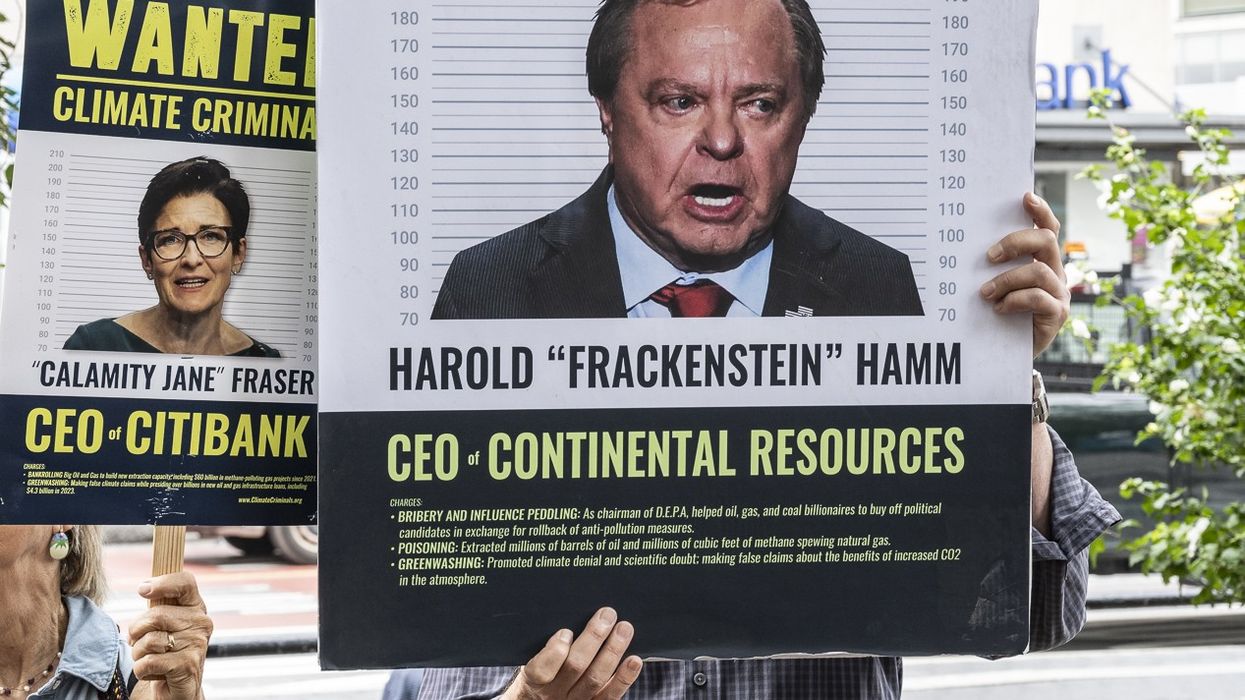'Earth's Greatest Enemy' Shows Us We Have No Choice
A new documentary details how the US military is destroying all forms of life—from oceans, plants, and animals to the communities it attacks and even the people who fight its wars.
In the opening scene of Abby Martin and Mike Prysner’s new documentary, Earth’s Greatest Enemy, an unhoused veteran sits and plays piano in an encampment in Brentwood, California. He lives in an encampment popularly known as “Veterans Row,” where tents are draped in US flags and people walking by are reminded of how often the U.S. military chews people up and spits them out. The man starts reciting the lines to an old Army recruiting commercial; the film cuts to the commercial itself, featuring the same unhoused veteran. He still remembers all the lines.
Earth's Greatest Enemy is a documentary about the climate crisis and imperialism: how the US military is the largest institution pushing us toward ecological collapse. At face value, the opening scene of a veteran who lives out on the street might seem unrelated. Over the course of the film, Martin, with careful precision, illustrates that the destruction of the climate by the US military is not only being done to the environment around us, but being done to us, as is shown in the scenes highlighting the contaminated water at Camp Lejeune.
Earth’s Greatest Enemy captures the unfathomable breadth of ecological and human suffering caused by militarism. It covers the cost of war to the oceans, animal and plant life, fresh water, and more. If someone lives in the belly of this military beast, Earth's Greatest Enemy should be a required watch.
One segment of the film focuses on the US military’s impact on Earth’s oceans, specifically during the US-led war games, RIMPAC, the largest maritime military exercise in the world. They fly Growler jets over the ocean and practice sinking exercises, exploding decommissioned ships in the open water. They fire live rounds and pollute the ocean for five or six straight weeks. Martin documents the US military detonating mountains in Okinawa and taking the dirt to fill in coral reefs so the military can use the land for part of a base. One of the film’s most surprising revelations is that the US military determines how many sea mammals they can kill. All of this, of course, affects fishing and biodiversity that sustains the oceans—and human and animal life around the world, most directly the people of the Pacific, whether it be Hawai’i, Okinawa, or the other islands where the US has set up permanent military outposts.
To fight for the future of the planet, we in the anti-war movement must join forces with the climate movement. Our enemies are one and the same: the war profiteers and politicians driving us toward climate collapse.
Earth’s Greatest Enemy also explores the water pollution caused by the US military. Halfway through the film, we hear from Kim Ann Callan, who has spent the last 15 years uncovering the impact of toxic waste from the military at Camp Lejeune. For years, the military poisoned the groundwater, which, in turn, poisoned military families. As a result, whole families got sick with cancer; the US military tried to cover it up. The film shows Callan walking through a cemetery with rows of gravestones of infants, with headstones reading “born and died” on the same date. Multiple families lost more than one baby to the illnesses caused by the military’s pollution.
Callan reflects: “Going into this, I had a whole different vision of the military. And I had a lot of respect for the military… I don’t have respect for the government or the military anymore.” The poisoning of military families on the base didn’t just happen at Camp Lejeune: The film exposes how toxic US military bases are worldwide—with just as devastating stories in each of the 800-plus military bases globally in over 80 countries and in hundreds throughout the US.
Martin, of course, discusses the impact conventional warfare has on the planet, like when the US or one of its proxies, like Israel, relentlessly bombards land over an extended period of time. The result is often total ecocide, where survivors have next to nothing left to grow and live off of.
The film reveals the cumulative impact of the bullets fired in Iraq. Conservative estimates suggest that, for every person killed in the US wars on Iraq and Afghanistan, more than 250,000 bullets were used. Each bullet injects lead, mercury, and depleted uranium into air, water, and land. Furthermore, studies have found titanium in the lungs of US soldiers on bases and in the hair samples of children in Iraq and Afghanistan. The US wages wars not only on the air, water, and land, but also on bodies, bloodlines, and generations of human beings.
The US military is destroying all forms of life. And for what? Even those who fight the wars are ultimately left out on the street when they return home.
By the end of the film, it’s abundantly clear: The US military is truly Earth’s greatest enemy. It controls—and threatens all life on Earth. Yet as organizers within the anti-war movement, it’s abundantly clear how siloed the fight against it can be from the rest of the environmental movement. To fight for the future of the planet, we in the anti-war movement must join forces with the climate movement. Our enemies are one and the same: the war profiteers and politicians driving us toward climate collapse.
Organizers on the front lines of the struggle against this planetary crisis of militarism—from Hawai’i to Okinawa to Atlanta—understand this. The struggle for the land is inextricably bound to the struggle against militarism. We have no choice but to cut through the political, philanthropic, and organizational red lines that separate us. Because, as Martin and Prysner elucidate, through compassionate human storytelling and radically honest journalism, the war machine will eventually come for us all. We must act now.


